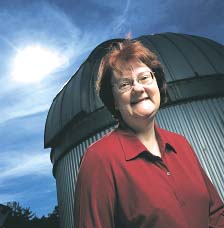 |
 |
| CURRENT ISSUE |  |
PAST ISSUES |  |
SEND A LETTER/NEWS |  |
ADDRESS UPDATE |  |
ADVERTISE |  |
ABOUT US |  |
ALUMNI HOME |
Features
Here Comes the SunPage 3 of 4
| SPACE EXPLORER |

|
|
Galvin earned her undergraduate degree in physics at Purdue University, then went to the University of Maryland as a graduate student. There, as a research assistant in the space physics group, she helped to analyze data collected by the International Sun-Earth Explorer satellites--her first work on a space project. It was the right time to get into space physics, she says. "It wasn't until Skylab [launched in 1973] that we were first able to get above Earth's atmosphere and get a look at the sun with X-rays. That opened up new insights; it cracked open the door. But to really get our foot in, we had to send up experiments that could not only look at the sun, but start to measure what's coming out of it." NASA began recruiting scientists to go into space as mission specialists in the mid-70s, and Galvin was among the first to apply. "They selected seven in the first round--all Ph.Ds, and I was still a grad student," she says. By the time she had her own Ph.D., she was too deeply involved in her research to take time out for astronaut training. "To tell the truth," she confides, "I get sick on a roller coaster, so I'm not sure it was all bad that I didn't get accepted. In this job, I get to do more basic science, and it's a lot less dangerous than being an astronaut." After earning both her master's and Ph.D. in physics at the University of Maryland, Galvin remained there as a member of the research faculty, working on six satellite missions. She came to UNH as a research associate professor in 1997. "The work I do is as much hardware as science," she observes. She's involved in designing and building satellite instruments, testing and calibrating them, operating them while they are in space, and analyzing the data they send back. The STEREO mission--Galvin's first as a principal investigator--is expected to advance our understanding of the mechanisms that connect events on the sun with consequences here on Earth. But Galvin hopes that new information about the solar wind will help to unravel even bigger mysteries. "In the thinnest outer layer of the sun, you have an almost pristine example of the original interstellar matter that our entire solar system was made of," she explains. "Some portion of that outermost layer comes out to us as the solar wind, and it can tell us a lot about the interstellar medium 4.7 billion years ago." |
Alex Crawshaw, a junior mechanical engineering major from Gilford, New Hampshire, has been part of the PLASTIC team since his freshman year. His workspace is tucked into one corner of a large room shared by about a dozen students assigned to various space science projects. Using a specialized computer-assisted-design program, he's constructed a computer model of a piece of PLASTIC called the time-of-flight chamber. "Basically, all it does is measure the speed and energy of particles that have been collected from the solar wind," he explains.
The time-of-flight chamber includes particle detectors that use carbon foils only a few atoms thick. They are so delicate that even a breath of air moving through the chamber would destroy them, yet the PLASTIC engineers had to design detectors rugged enough to withstand the stresses of launch and the space environment. When prototypes of the detectors were sent to the Goddard Space Flight Center for testing in a NASA lab, Crawshaw went along. "I spent a whole week there, working with NASA engineers," he says. "That was big. That was fun."
Crawshaw, who dreams of an assignment aboard the international space station someday, still finds it amazing that he's able to work on a NASA project as an undergraduate. "It's pretty cool to think that in 2005, this piece I'm working on will be orbiting above my head somewhere," he observes.
He's also excited to be working directly with a scientist of Galvin's stature. "I usually see her a couple of times a day. When I come up with a problem, the first thing I do is go to her with all of my documentation. We might spend a couple of hours in her office, going over ideas to work it out. She has extensive knowledge of ... well, just about everything, it seems to me."
That breadth of knowledge is a prerequisite for the principal investigator in a major space experiment. "You need someone who has seen a lot of previous research, remembers it, and knows how to apply it to the current project at the right time," says UNH physicist Mark Popecki, a coinvestigator for the STEREO project. "Toni knows the science and has had enough experience with the hardware to make good decisions about which engineering approaches will work best. And when something isn't working, she has good intuitions about what might be going wrong."
STEREO is the third of five solar-terrestrial probes planned by NASA to improve our ability to predict weather in space. One of its principal objectives is to collect data that will help forecasters to predict the effects of CMEs more accurately. CMEs are the most violent eruptions that occur on the sun and the cause of most major geomagnetic storms. Unfortunately, the CMEs that affect Earth most are the ones that are least likely to be detected by telescopes on the ground or by satellites in orbit around the planet, simply because it's hard to see something that's coming right at you. That's why each STEREO satellite will orbit the sun in a position far enough from Earth to provide a different perspective.
Page: < Prev 1 2 3 4 Next >Easy to print version

